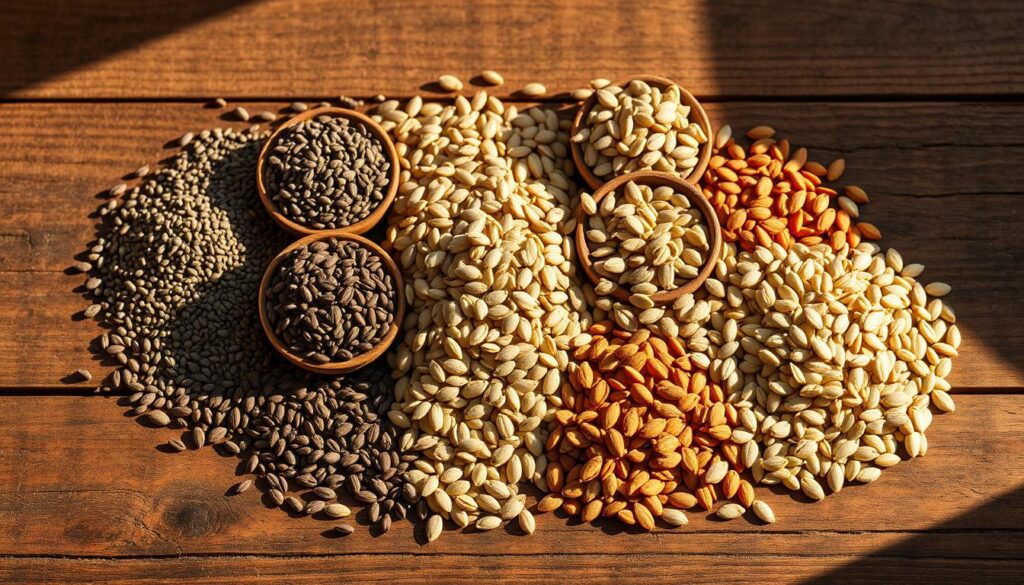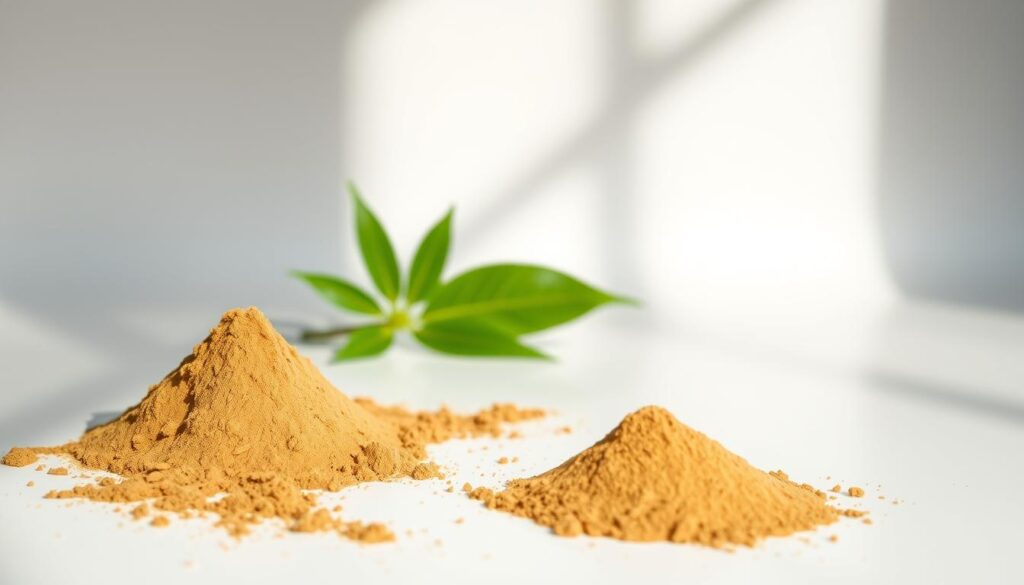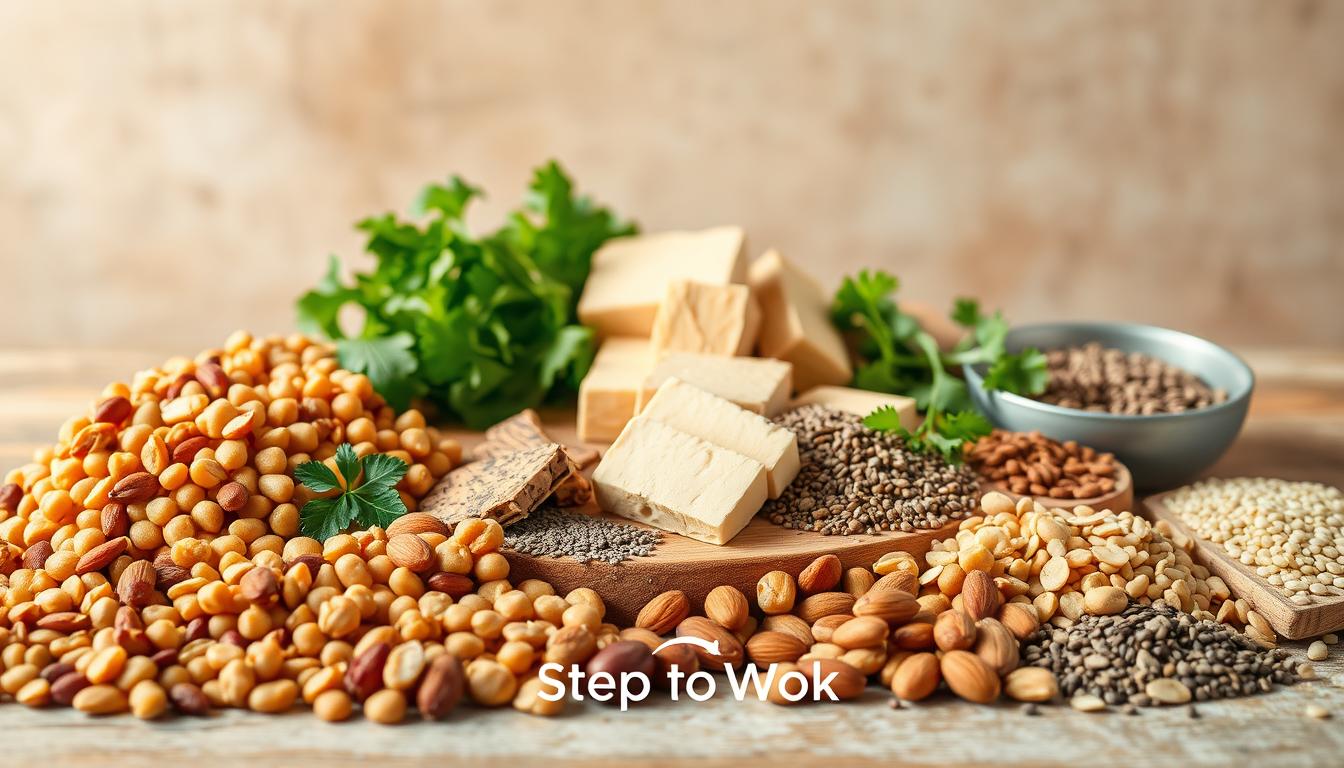A balanced lunch is key for keeping your energy up and staying healthy. Plant-based proteins are important for this, giving you the amino acids you need. The 2020-2025 Dietary Guidelines say 10%-35% of your calories should be from protein. This means 200 to 700 calories from protein daily for a 2,000-calorie diet.
Adding plant-based proteins to your meals is good for everyone. Whether you’re a vegetarian, vegan, or just want more plant-based meals, it’s beneficial. Legumes, whole grains, and nuts are great sources of protein.
A 1-cup serving of cooked quinoa has about 8 grams of protein. Tofu, a 3-ounce serving, also has around 8 grams. Seeds like hemp and chia are packed with protein, too. Hemp seeds have 10 grams per serving, and chia seeds have 4 grams.
It’s easy and tasty to add plant-based protein to your lunch. There are many options to choose from. This way, you can make a healthy and satisfying meal. Plant-based proteins support healthy eating and a balanced diet.
Key Takeaways
- Incorporating plant-based protein sources into your diet can provide the necessary amino acids for optimal health.
- Legumes, whole grains, and nuts are all high in protein and offer a range of health benefits.
- Plant-based protein sources can be easy to incorporate into your lunch, with options like tofu, tempeh, and seeds.
- A well-balanced lunch that includes plant-based protein sources can support energy levels and overall health.
- Plant-based eating can be beneficial for everyone, whether you’re a vegetarian, vegan, or simply looking to add more plant-based meals to your routine.
- Healthy eating and balanced diets can be achieved by choosing plant-based protein sources like plant-based protein, vegetarian lunch, and healthy eating.
- Plant-based protein sources can provide up to 25 grams of protein per day, which is associated with various health benefits.
Understanding Plant-Based Proteins
Plant-based proteins are key to a healthy diet, bringing many health benefits when part of balanced meals. With vegan and vegetarian diets on the rise, it’s simple to add plant-based lunch ideas to your day.
A smart plant-based diet can lower the risk of serious diseases like heart disease, stroke, and type 2 diabetes. The main advantages of plant-based proteins are:
- Lower saturated fat content
- Higher fiber content
- Lower risk of chronic diseases
What Are Plant-Based Proteins?
Plant-based proteins come from various sources like legumes, whole grains, nuts, and seeds. Examples include lentils, chickpeas, black beans, and quinoa.
Benefits of Plant-Based Proteins
Plant-based proteins offer many benefits, including a lower risk of heart disease, stroke, and type 2 diabetes. They also tend to have less saturated fat and more fiber than animal proteins.
Nutritious Legumes for Your Lunch
Legumes are packed with protein and fiber, making them perfect for a balanced vegetarian lunch. You can add them to soups, stews, salads, and wraps. Lentils, chickpeas, and black beans are some of the best options.
These legumes are not just high in protein but also in fiber. For instance, a ½-cup of cooked lentils has about 9 grams of protein and 8 grams of fiber. Chickpeas offer 7 grams of protein and 6 grams of fiber per ½-cup serving.
Lentils
Lentils are a legume that’s rich in protein and fiber. They’re also low in calories and full of nutrients like iron and potassium.
Chickpeas
Chickpeas are another legume that’s high in protein and fiber. They’re also a good source of folate and iron, making them great for a balanced vegetarian lunch.
Black Beans
Black beans are a legume that’s high in protein and fiber. They’re low in calories and full of folate and iron, making them perfect for protein-rich meals.
Whole Grains to Incorporate
Whole grains are key for a healthy diet. They are packed with plant-based protein, fiber, and minerals. Quinoa, brown rice, and farro are great for a nutritious lunch. You can use them as sides or as the base for salads and bowls.
Whole grains are full of fiber, which helps you feel full longer. This can help with weight loss. They also don’t cause blood sugar spikes like refined grains do. Plus, their soluble fiber lowers cholesterol and feeds good gut bacteria.
Here are some high-protein whole grains:
- Quinoa, which contains 8 grams of protein per 1 cup
- Farro, which contains 8 grams of protein per 1 cup
- Sorghum, which contains 10 grams of protein per 1 cup
Adding whole grains to your meals is simple and tasty. Use quinoa or farro for salads, or brown rice in stir-fries. With their health perks and protein, whole grains are a smart choice for a healthy diet.
Seeds and Their Benefits
Seeds are a great way to add protein to your diet. They are packed with protein, omega-3 fatty acids, and fiber. This makes them perfect for plant-based lunch ideas and balanced meals.
Chia Seeds
Chia seeds are full of protein and can soak up a lot of water. This helps keep you hydrated and full. You can add them to salads, smoothies, and yogurt. They’re a fantastic choice for plant-based lunch ideas.
Hemp Seeds
Hemp seeds have the most protein of any seed. They’re also rich in omega-3 fatty acids and fiber. This makes them a top pick for balanced meals.
Flaxseeds
Flaxseeds are a good source of protein and omega-3 fatty acids. They’re also high in fiber. This can help lower cholesterol and keep you hydrated. They’re a great addition to plant-based lunch ideas and balanced meals.
Seeds offer many benefits. They are:
- High in protein and omega-3 fatty acids
- Rich in fiber and antioxidants
- Can help lower cholesterol levels and aid in hydration and satiety

Delicious Nuts for Protein Boost
Nuts are a tasty and convenient way to add plant-based protein to your diet. They support healthy eating habits. Almonds, walnuts, and cashews are some of the most protein-rich nuts.
These nuts are not only delicious but also provide a lot of protein. For example, almonds have about 7g of protein per 1/4 cup. Cashews have 5g of protein per 1/4 cup. Walnuts have 4.5g of protein per 1/4 cup. Adding these nuts to your diet can help you meet your daily protein needs. This supports healthy eating and overall well-being.
- Almonds: 7g per 1/4 cup serving
- Cashews: 5g per 1/4 cup serving
- Walnuts: 4.5g per 1/4 cup serving
- Pistachios: 6g per 1/4 cup serving
- Peanuts: 9.5g per 1/4 cup serving
Adding these protein-rich meals to your diet can help you eat healthily.
| Nut | Protein Content per 1/4 cup serving |
|---|---|
| Almonds | 7g |
| Cashews | 5g |
| Walnuts | 4.5g |
| Pistachios | 6g |
| Peanuts | 9.5g |
Tofu: A Versatile Protein Source
Tofu is a soy product that’s high in protein and great for a vegetarian lunch. It’s packed with nutrients and is a top choice for plant-based protein. Each serving of tofu has 17g of protein, perfect for boosting your protein intake.
There are many types of tofu, like silken, regular, firm, extra-firm, and super-firm. Firm tofu has 8-9g of protein per 85g serving. It’s also low in fat, with only 4g of fat per 100g serving. Plus, it has a low glycaemic index, making it good for those with dietary restrictions.
Some benefits of tofu include:
* It’s high in protein and low in calories
* It’s low in saturated fats and cholesterol-free
* It’s rich in unsaturated fats and fiber
* It’s great for vegans, gluten-free, and lactose-free diets
* It’s FODMAP-friendly and low in salt
Eating tofu can help lower the risk of heart disease, type 2 diabetes, and some cancers. With its many benefits, tofu is a fantastic choice for a plant-based protein diet and a vegetarian lunch.
| Nutrient | Amount per 100g serving |
|---|---|
| Calories | 70 |
| Protein | 8g |
| Fat | 4g |
| Carbohydrates | 2g |
Tempeh: The Fermented Protein Option
Tempeh is a fermented soy product that’s packed with protein and probiotics. It’s a fantastic choice for balanced meals. Its nutty taste and firm texture make it perfect for plant-based lunch ideas.
A 3-ounce serving of tempeh has 162 calories, 15 grams of protein, and 9 grams of carbs. It’s also full of fiber, iron, and calcium. This makes it a nutritious part of any meal. Here are some key benefits of tempeh:
- High protein content: 15 grams per 3-ounce serving
- Rich in fiber: 10 grams per 3-ounce serving
- Good source of iron: 12% of the recommended daily intake
- Good source of calcium: 9% of the recommended daily intake
Tempeh can be used in many dishes, like salads, stir-fries, and sandwiches. It’s also a great meat substitute. It has a meat-like texture and can be marinated and cooked like meat.
Plant-Based Protein Powders
Plant-based protein powders are great for adding protein to your diet. They’re easy to mix into smoothies, oatmeal, or yogurt. This makes them perfect for those who are always on the go and want to eat healthy.
Look into pea protein, hemp protein, and brown rice protein. These options are not only high in protein but also gentle on your stomach. They’re also good for people with allergies.
Popular Options
- Pea protein: high in essential amino acids and easy to digest
- Hemp protein: complete protein source with all nine essential amino acids
- Brown rice protein: hypoallergenic and easy to digest
How to Use Protein Powders
To add plant-based protein powders to your diet, start with a scoop in your favorite smoothie. You can also mix it with almond milk or yogurt. Using protein powders as a supplement can help you meet your daily protein needs.

Choosing plant-based protein powders supports your health and wellness. There are many options out there. It’s easy to find one that fits your dietary needs and tastes.
Dark Leafy Greens for Nutrition
Incorporating dark leafy greens into your plant-based lunch ideas is a smart move. These greens are full of vitamins, minerals, and antioxidants. They make a great addition to a balanced vegetarian lunch.
Spinach, kale, and collard greens are among the most nutritious. For instance, kale has about 68% of the daily vitamin K you need in one cup. Spinach packs 121% of vitamin K in just one cup. You can toss them into salads, smoothies, or sautés. This makes them a flexible way to enhance your meals’ nutritional value.
Here are some key benefits of dark leafy greens in your diet:
- High in vitamins and minerals, including vitamin K, vitamin A, and calcium
- Rich in antioxidants and anti-inflammatory compounds
- Supports healthy digestion and bowel function
- May help reduce the risk of chronic diseases, such as heart disease and certain cancers
Adding dark leafy greens to your meals is simple and tasty. Try them in your favorite dishes or as a base for salads and smoothies. Their health benefits and versatility make them a fantastic choice for any plant-based lunch ideas or balanced vegetarian lunch.
| Green | Vitamin K (DV%) | Vitamin A (DV%) | Vitamin C (DV%) |
|---|---|---|---|
| Kale | 68% | 6% | 22% |
| Spinach | 121% | 16% | 12% |
| Collard Greens | 131% | 10% | 20% |
Delicious Plant-Based Meats
Plant-based meats are a tasty and easy way to get plant-based protein in your diet. They work well in many dishes, like burgers, sandwiches, stir-fries, and curries. With more people looking for healthy eating options, many brands now offer plant-based meat alternatives. These are not only delicious but also packed with protein.
Some top brands to check out are Beyond Meat and Impossible Foods. They have a variety of products, from burgers to sausages, all made from plant-based ingredients and high in protein.
Brands to Try
- Beyond Meat
- Impossible Foods
- Quorn
Cooking with plant-based meats is simple and versatile. You can grill, bake, or sauté them, just like regular meat. Many are also pre-seasoned, which is great for those who are short on time but want to add flavor to their meals.
Cooking with Plant-Based Meats
When cooking with plant-based meats, always follow the package instructions for the best taste. You can also try different seasonings and marinades to enhance your dishes. With a bit of creativity, you can make tasty and healthy eating meals that are full of plant-based protein and perfect for any time.
| Brand | Product | Protein Content |
|---|---|---|
| Beyond Meat | Burger Patty | 22g |
| Impossible Foods | Ground Beef | 19g |
| Quorn | Chicken Nuggets | 15g |
Crafting a Balanced Lunch Plate
To make a balanced lunch plate, mix foods from different groups. Aim for 50% fruits and veggies, 25% protein, and 25% whole grains. This mix gives you protein, healthy fats, and carbs for balanced meals that boost health.
Choose protein like beans, lentils, and nuts for their protein and fiber. Pair them with whole grains like brown rice or whole wheat bread for energy. Colorful fruits and veggies add flavor, texture, and vitamins.
Here are some tips for crafting a balanced lunch plate:
- Include a source of protein, such as beans, lentils, or nuts
- Choose whole grains, like brown rice, quinoa, or whole wheat bread
- Add a variety of colorful fruits and vegetables
- Limit sugary drinks and foods high in salt and unhealthy fats
By following these tips, you can make balanced meals with a variety of foods. This ensures you get the nutrients you need for health. Drink water and avoid sugary drinks. With a bit of planning, you can make a protein-rich meal that tastes great and is good for you.
| Food Group | Recommended Portion |
|---|---|
| Fruits and Vegetables | 50% of the plate |
| Protein Sources | 25% of the plate |
| Whole Grains | 25% of the plate |
Quick and Easy Plant-Based Recipes
We’ve explored plant-based protein sources and now share quick, easy recipes for your lunch. Enjoy satisfying salads, flavorful wraps, hearty bowls, and protein-packed snacks. These recipes will make your midday meal balanced and delicious.
Salad Ideas
Start with a nourishing salad. Mix colorful veggies, beans, and seeds. Try a Quinoa and Black Bean Salad or a Kale and Lentil Salad for a protein boost. For something creamy, blend a Cashew-Based Caesar Salad.
Wraps and Bowls
Use whole grains like quinoa and brown rice for satisfying bowls. Add sautéed tofu, tempeh, or plant-based meat. Wrap your lunch in a Hummus and Avocado Wrap or a Tempeh and Veggie Burrito.
Snacks with Protein
Need a protein boost? Try homemade trail mix with nuts, seeds, and dried fruit, or edamame with sea salt. Dip fresh veggies in creamy oil-free hummus for a crunchy snack.
These quick, easy plant-based lunch ideas will fuel your body and please your taste buds. Experiment with flavors and textures to find your new favorite lunches.

